As a chef at Food And Meal, I have a deep passion for cooking and sharing delicious food with others. Over the years, I’ve experimented with flavors and techniques from around the world, but one dish that holds a special place for me is the classic Japanese stir-fry Noodles, yakisoba.
Perhaps it’s the memories of the sweet and tangy sauce coating the noodles that reminds me of my time living in Japan when I was just starting out as a chef. Or maybe it’s the satisfaction of stir-frying a rainbow of fresh vegetables like cabbage, carrots, shiitake mushrooms, and green onions, their colors popping as they mix with the glistening brown noodles.
Whatever it is, yakisoba fills me with nostalgia and comfort. It may seem simple – just noodles, vegetables, meat or tofu, and a flavorful sauce – but as with any dish, the magic is in the details. Finding that perfect balance of salty, sweet, and umami in the sauce gives the noodles a wonderful depth of flavor. Letting the noodles soak up that sauce while maintaining just the right texture requires finesse.
As much as I love the smoked meat dishes we serve up at the restaurant, coming home after a long day and making yakisoba is my way to unwind. The sizzle of ingredients in the pan, the tantalizing aromas as everything comes together – it’s both relaxing and rewarding. Then taking that first big bite of saucy noodles still warm from the stovetop, vegetables snapping between my teeth, is just pure happiness.
I hope you’ll give this yakisoba recipe a try and let the noodles transport you like they do for me. Whether enjoyed on a quiet night at home or shared with friends at your next dinner party, it’s a dish guaranteed to satisfy. Just be prepared to see those noodles disappear fast once you plate them up!
Best Yakisoba Recipes
“Yakisoba” is a Japanese word for fried noodle. It is a stir-fry made with Chinese wheat flour noodles. Typically, yakisoba is flavored with Worcestershire sauce. It first appeared in food stalls after World War II. It is often accompanied by a side of vegetables. You may have heard of grilled cheese and chili sauce, but did you know that yakisoba is also available in North America?
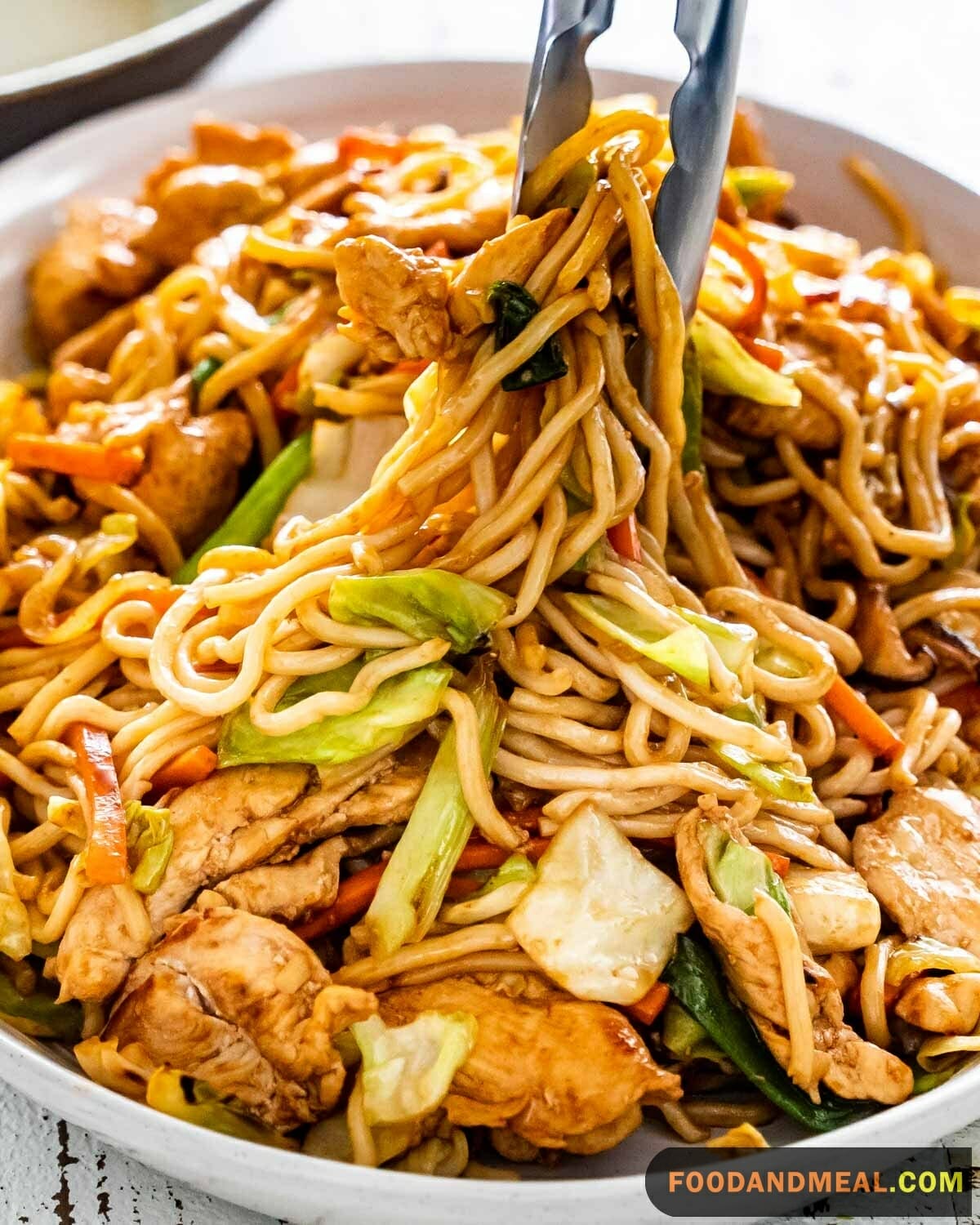

Yakisoba
Equipment
Ingredients
- Vegetable oil for frying
- 1⅓ pounds noodles cooked, such as Chukasuimen
- 1⅓ cups Pork Chashu diced
- 1⅓ cups chopped cabbage
- Salt
- ground black pepper Freshly
- 1⅓ cups bean sprouts
- ½ cup soy sauce
- Benishoga red pickled ginger
- Aonori dried green nori
- Katsuobushi bonito flakes
Instructions
- Heat a large wok over high heat. Add a little oil and loosen and fry the noodles with just enough oil to keep them from sticking.
- When the noodles are slightly browned, about 3 minutes, remove from the wok and set aside.
- Add a little more oil to the wok and stir-fry the chashu for 1 to 2 minutes.
- Add the cabbage with a little salt and pepper. Cook until the cabbage starts to soften, about 2 minutes. Add the noodles and bean sprouts, and toss to mix.
- Pour the soy sauce evenly over the yakisoba. Stir-fry for another 1 to 2 minutes.
- Serve topped with pickled ginger, nori, and bonito flakes.
Video
Notes
Nutrition
© Food And Meal
This website provides approximate nutrition information for convenience and as a courtesy only. Nutrition data is gathered primarily from the Spoonacular Database, whenever available, or otherwise other online calculators.
Air Fryer Yakisoba
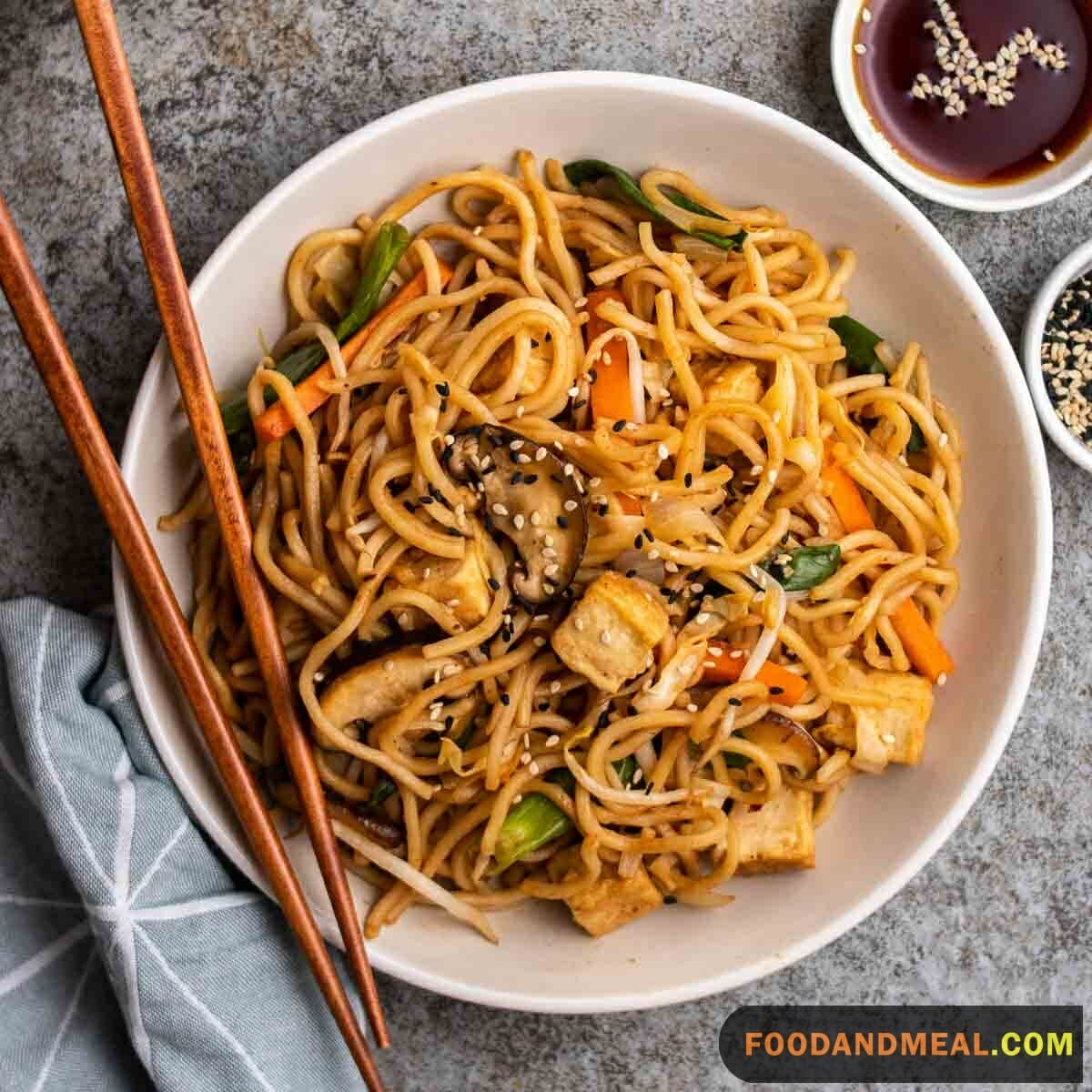
Ingredients:
- 2 cups yakisoba noodles
- 1 tablespoon olive oil
- 1 small onion, sliced
- 2 cloves garlic, minced
- 1 bell pepper, sliced
- 1 carrot, julienned
- 200g chicken, beef, or tofu, sliced
- 2 tablespoons soy sauce
- 1 tablespoon Worcestershire sauce
- Salt and pepper to taste
- Garnish: Green onions, sesame seeds
Instructions:
- Preparation: Start by heating the air fryer to 390°F (200°C). This preheating stage is essential to ensure that every ingredient cooks evenly and absorbs the flavors exquisitely.
- Cooking the Protein: Toss your chosen protein (chicken, beef, or tofu) in a bowl with a dash of olive oil, salt, and pepper. Spread it in a single layer in the air fryer basket and cook for about 8-10 minutes, or until it’s nicely browned and cooked through. Remove and set aside.
- Vegetables: In the same bowl, mix the sliced onion, bell pepper, and carrot with olive oil. Air fry the veggies for about 6-8 minutes until they are tender and slightly caramelized.
- Combining: While the veggies are cooking, in a large bowl, toss the yakisoba noodles with a bit of oil to separate them. Once the veggies are done, mix the cooked protein, vegetables, and noodles together. Drizzle with soy sauce and Worcestershire sauce, toss to combine.
- Final Touch: Put the mixture back into the air fryer and cook for an additional 5 minutes to let the flavors meld together and give the noodles a slightly crispy texture.
- Garnishing: Serve your air fryer Yakisoba garnished with sliced green onions and a sprinkle of sesame seeds for that extra layer of flavor and aesthetic touch.
Tips for making Yakisoba
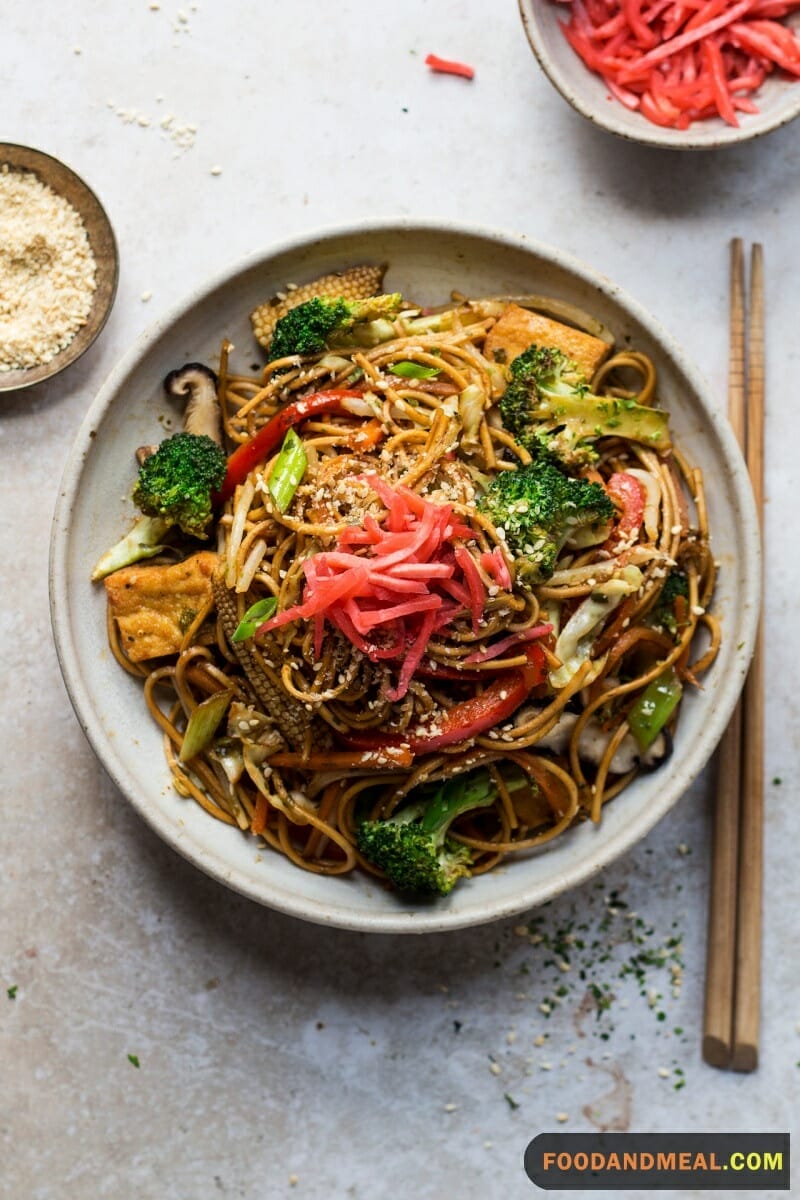
Cooking Tips
- Temperature is Key: Maintaining the right heat ensures the noodles get that golden touch without losing their tender allure. Keep it medium-high; let the ingredients dance, not burn.
- The Art of Tossing: Perfecting the toss ensures each noodle, every piece of vegetable, is kissed by heat and infused with flavor. It’s a symphony; let each element play its part.
- Common Mistakes: Avoid overcooking the noodles; we seek a tender yet firm bite, a golden touch, not a crispy crunch. And balance your sauces; let them accentuate, not overpower the delicate dance of flavors unfolding in your pan.
Serving Suggestions
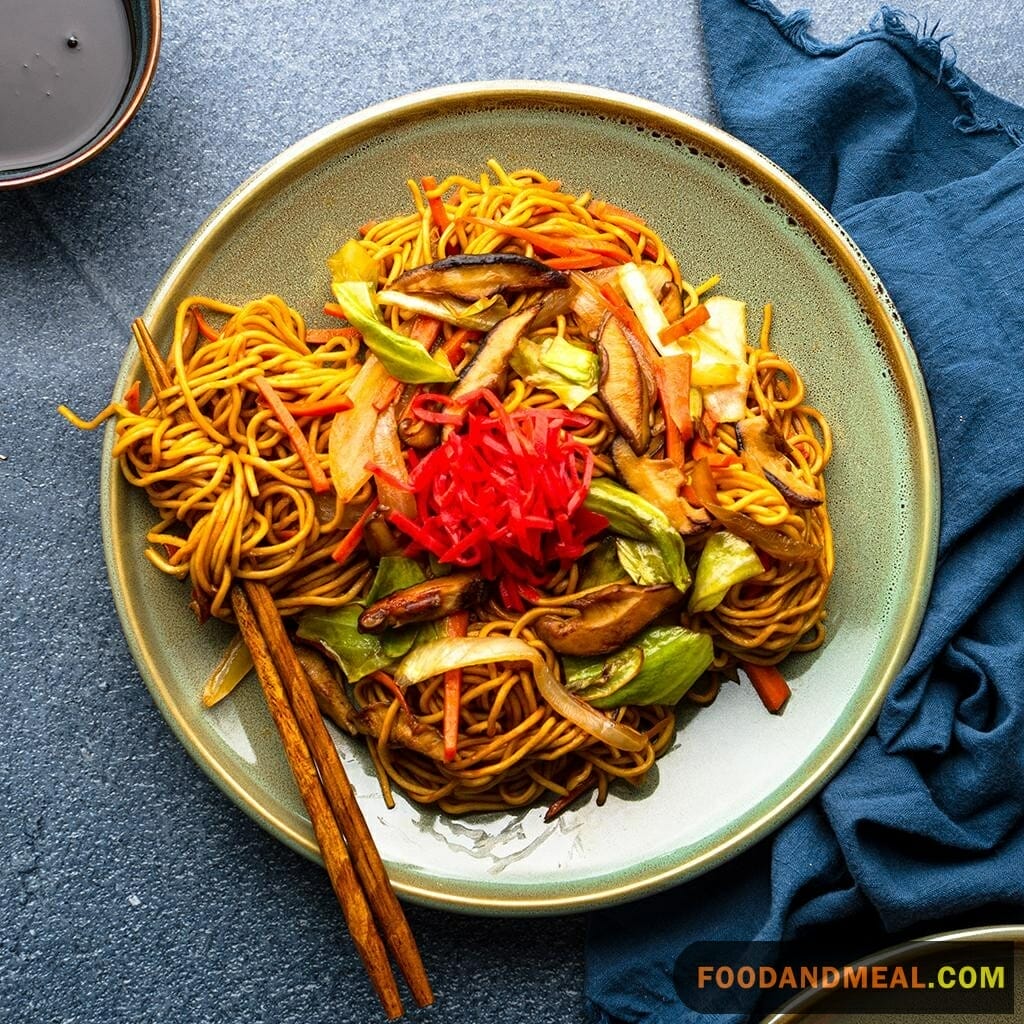
Yakisoba would pair well with lighter, healthier dishes like salads, vegetable sides, and grilled or poached fish. Some examples of recipes that would complement yakisoba include:
- Fish Skewers on Farmer’s Salad
- Grilled Sea Bream
- Whole Wheat Cheese Toast
- Tramezzini with Peppers
- Quesadillas with Vegetables
- Grilled Bread
- Ciabatta with Tomato, Mozzarella, and Basil Pesto
- Mesclun and Artichoke Salad
- Eggplant Parmesan Stacks
- Pesto-ranch pasta salad
- Greek Veggie Mix
- Veggie Yellow Rice
- Mushroom Cabbage Hot Pot
- Thai Green Chicken Curry with Vegetables
- Sweet And Spicy Roasted Vegetables
- Bunny Chow
- Paleo Baked Potato Salad
The tangy and savory flavors of the yakisoba would balance out lighter dishes focused on fresh vegetables, greens, and lean proteins. The noodles could also be served as a heartier side option next to curries or stir fries. Let the yakisoba be the star and pair it with simple sides that won’t overpower.
FAQs of Yakisoba
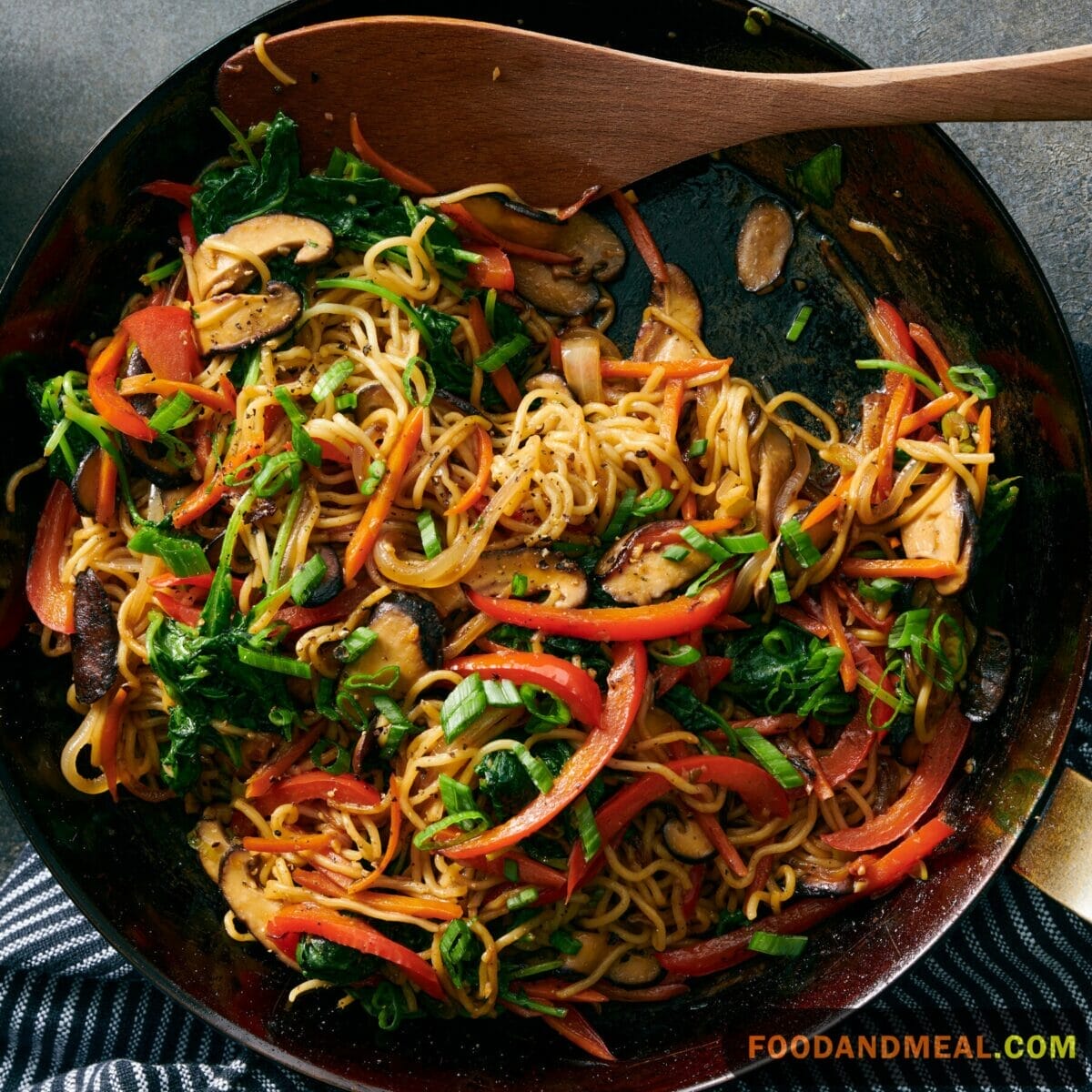
- Can I Prepare Yakisoba with Other Types of Noodles? Indeed, while traditional Yakisoba noodles are a classic choice, feel free to innovate with ramen or udon noodles. Each brings a distinct texture and character, adding a unique twist to the dish.
- How to Store Leftover Yakisoba? Cool the leftover Yakisoba to room temperature, then transfer it to an airtight container. It can be stored in the refrigerator for up to 3-4 days. Reheat on a stovetop with a little oil for the best flavor and texture revitalization.
- Can I Add Different Proteins? Absolutely. Yakisoba is versatile. Feel free to experiment with shrimp, pork, or even go vegetarian with tofu or tempeh. Each protein adds its unique flair, making the dish wonderfully adaptable.
- Is Yakisoba Spicy? Traditionally, it’s not very spicy. However, feel free to add some heat with a dash of chili oil or some sliced fresh chilies to cater to your taste buds.
- Can I Make it Gluten-Free? Yes, substitute the regular soy sauce with tamari or gluten-free soy sauce, and ensure your noodles are gluten-free. Always check the labels on each ingredient to ensure they meet your dietary requirements.
Conclution
In conclusion, yakisoba holds a special place in my heart and on my dinner table. Its balance of flavors and textures, as well as the memories it evokes, make it a dish I never tire of cooking. I find making yakisoba to be a soothing, rewarding process after long days working at my restaurant. And that first bite of glistening noodles and crisp-tender vegetables always transports me back to my early days as a chef in Japan.
I hope my passion for this classic stir-fry will inspire you to give yakisoba a try soon. Play around with ingredients to make it your own, but don’t overlook the importance of properly seasoning the noodles and letting them soak up that sweet and salty sauce. Once you master the technique, I have no doubt you’ll be as hooked as I am. Just be ready for the noodles to disappear quickly whenever you serve them up!
I'm James F Anderson, a noted sous chef from London and a Le Cordon Bleu alumnus. My career began in a Michelin-starred Parisian eatery, where my blend of classic and contemporary cooking, using seasonal ingredients, earned accolades. Recognized in culinary publications and on cooking shows, I’m committed to mentoring aspiring chefs and delivering memorable dining experiences, marking me as a standout talent in the culinary world.

